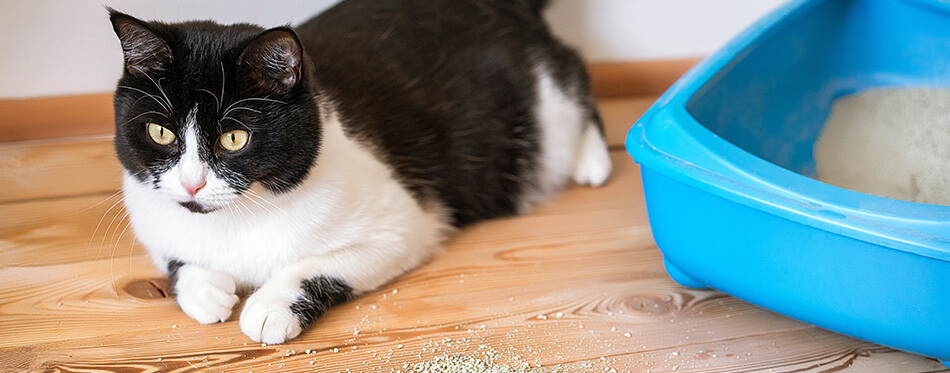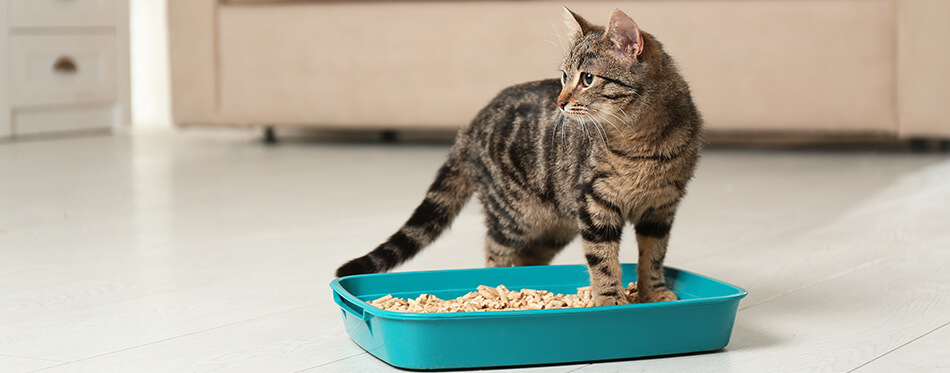When cat litter is tracked through your home, we know it can be frustrating. It’s difficult to not blame your cat for tracked litter, but it really isn’t their fault. Cats have a lot of instincts that are coded into their behavior, including the need to cover their waste. In this guide, we’ll look at what pet parents can do to prevent or minimalize litter tracking, as well as what causes it.
What is Cat Litter Tracking?
As you may have guessed, cat litter tracking is when your cat tracks pieces of litter from inside their litter boxes to outside of their litter boxes. This usually means that the litter ends up surrounding the area where you’ve placed the litter box, and it can get pretty tedious to clean up every day. It’s possible for the litter to end up getting tracked through your home, too.
Why Cats Track Litter from Their Litter Box
When we say that cats don’t mean to track litter, we’re being completely truthful. The reason that cats track litter is that the litter gets stuck to the cat’s paws, specifically the fur on their paws or around their pads and nails.
As the cat gets out of the litter box, they take the trapped litter with them. It comes loose from the cat’s paws as they walk away from the box. It creates a track of litter from the box to where your cat went, hence “litter tracking”.
Some of the litter surrounding the litter box might not be from tracking, but from the digging action that cats do after they’ve finished using the bathroom. Their goal is to cover their waste, so they don’t pay particular attention to the litter that they’re scooping from one side of the box to the other.

How to Prevent Tracking
You’ve tried other ways to help minimize litter tracking but nothing seems to be sticking. With the help of our suggestions below, cat owners can combat tracking in the best ways. It may seem like a lot of steps, but these can really help keep litter out of your home or at least create easy clean-up.
Use a Litter Mat
Cat litter mats are made of rubber and have groves that can catch litter when your cat walks on them. These mats are extremely affordable, come in a variety of colors, and they’ll help keep the litter scatter in one place. The only issue with them is that they can be hard to clean and sometimes cats mistake them for an extra litter box to use. Cleaning waste from the groves is messy and difficult.
The best litter mats should be comfortable, durable, and easy to clean. If you stay on top of poop scooping and freshening the litter in your cat’s litter tray, a litter mat is a great way to prevent the spread of litter.
Place Your Cat’s Litter Box on Carpet
You don’t need to move your kitty’s litter box into a carpeted room – that’s just asking for a disaster – but you can use a carpet runner to make it so less litter is dragged across your house. Place small carpet runners just under the edge of the litter tray so that your cat walks on the carpet when they leave the tray, rather than smooth flooring. Many cats will lose the litter they’ve picked up in a short walk.
Alternatively, you can use a litter mat or a shaggy bath mat. Anything cat can catch the litter from the feet of your multiple cats will help reduce tracking.
Move Your Cat’s Litter Box
Cat people tend to keep their cat’s litter box in the bathroom or in the corner of their living room. As long as you keep the box where it belongs, cats won’t get frustrated about its location – but the area you choose to put it should be quiet and have little foot traffic. Litter box location is important for odor control and keeping litter contained.
If you find that litter tracking has become an issue where you currently have the box and putting a litter mat underneath it hasn’t helped, it may be time to move the litter tray.
Change Your Cat’s Litter Box Type
Some kinds of cat litter will track easier than others. The majority of cat owners will purchase clumping clay litter because it’s accessible and affordable, but clay litter is one of the biggest culprits of tracking. The litter pebbles can stick to your cat’s paw pads and wet litter of this variety sticks together at the bottom of the litter box.
If you must buy a type of litter that clumps, use one that can clump immediately. Cats end up standing in wet litter, it gets stuck to their little kitty’s paws and ends up outside of the litter box. The wetter litter can also stick itself to dry litter, which is a waste of the product.
Best Litter for Your Cat’s Litter Tray
- Ultra clumping litter
- Pellet cat litter
- Natural cat litter
- Clay litter that consists of larger pieces
- Dust-free litter
Trim Your Cat’s Paw Fur
This may seem like a weird solution but less fur to stick to means less litter tracked through your home. Long-haired cats, especially, could benefit from having the fur at the bottom of their feet trimmed. Most cats don’t need this done, but if you’ve noticed that more than one cat in your household is tracking, trimming their feet fur may help.
Use a Taller Litter Tray
Taller litter trays will help keep litter inside the box because their structure makes it more difficult for your cat to kick litter out. High-sided litter boxes are designed with high walls as an alternative for cat owners who find that their cats make too much of a mess with common litter trays when flinging litter about.
Try a covered litter box, too. These can stop litter from tracking because litter rarely ends up getting flung by your cat while inside of it.
The Creative Solution
Some crafty cat owners make their own kind of bathroom cat furniture using a hooded tray, a large opaque storage box, and a litter mat. You make a cat door on the side of the large storage box, sand the edges until smooth, and then place the mat and litter box inside of it. It creates an enclosed bathroom place for your cat, without the possibility of having cat litter tracked through your home. As a cat owner, this has the potential to be the best solution for you. The only issue is that multi-cat households may need a second large box made, and they can take up some space.
Things to Avoid When Trying to Stop Litter Tracking
- Scolding your cat. It isn’t their fault and scolding them is just going to make them stressed, which can lead to other issues.
- Walking around your home with bare feet. You never know what you might stand in!
- Keeping the litter tray on a tile or laminate floor without any kind of mat.
- Using a cheap litter tray rather than a high-sided litter box (unless you have an elderly or ill cat who can’t use them).
- Changing the litter box multiple times. Changes make cats nervous. Try adding litter mats or put the litter box in a quieter location first. Your cat’s scent is all over their current box.
- Don’t use more litter. Your cat isn’t tracking because they don’t have enough litter, and it’ll end up costing you more money.

FAQs:
Q: Is there a cat litter that doesn’t track?
A: There are better cat litters that can reduce tracking and some that are marketed to say that they don’t track at all. We’ve included a few suggestions above, but you’ll basically want to avoid dusty, cheap cat litters, and clay litter with small particles.
Q: Will a top-entry litter box stop litter tracking?
A: Like enclosed litter trays and high-walled litter trays, top-entry litter boxes have the potential to reduce or even eliminate tracked litter. Cat owners need to be aware that there’s always a chance that litter will still be tracked, but changing to a top-entry box can stop litter from exiting the tray.
Q: How do I clean out a litter tray without spreading litter everywhere?
A: Place the whole tray into a trash bag if you can, then tip the tray’s contents out. This will help you avoid any pieces of stray litter stuck around the rim. Litter falls from the tray rim during cleaning and ends up on the floor, which can be frustrating if you’ve just swept. Alternatively, use cat tray liners with their own drawstring ties for easy and quick disposal.

